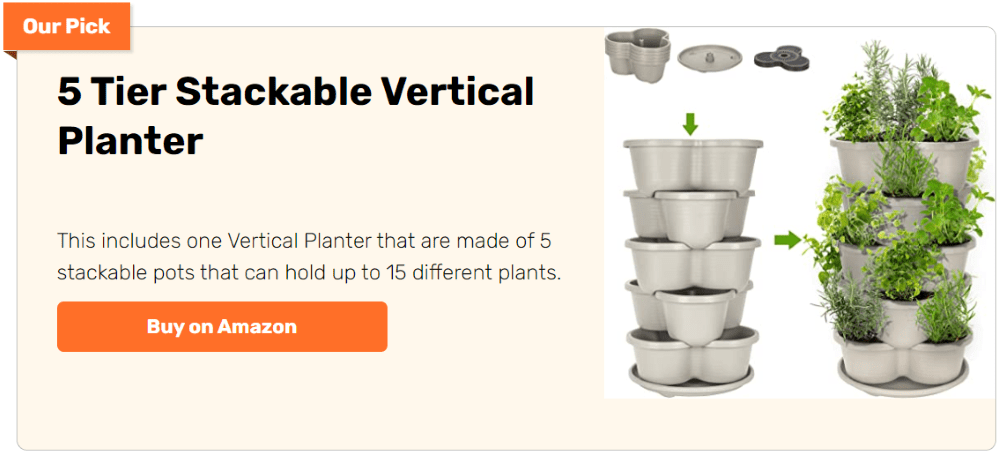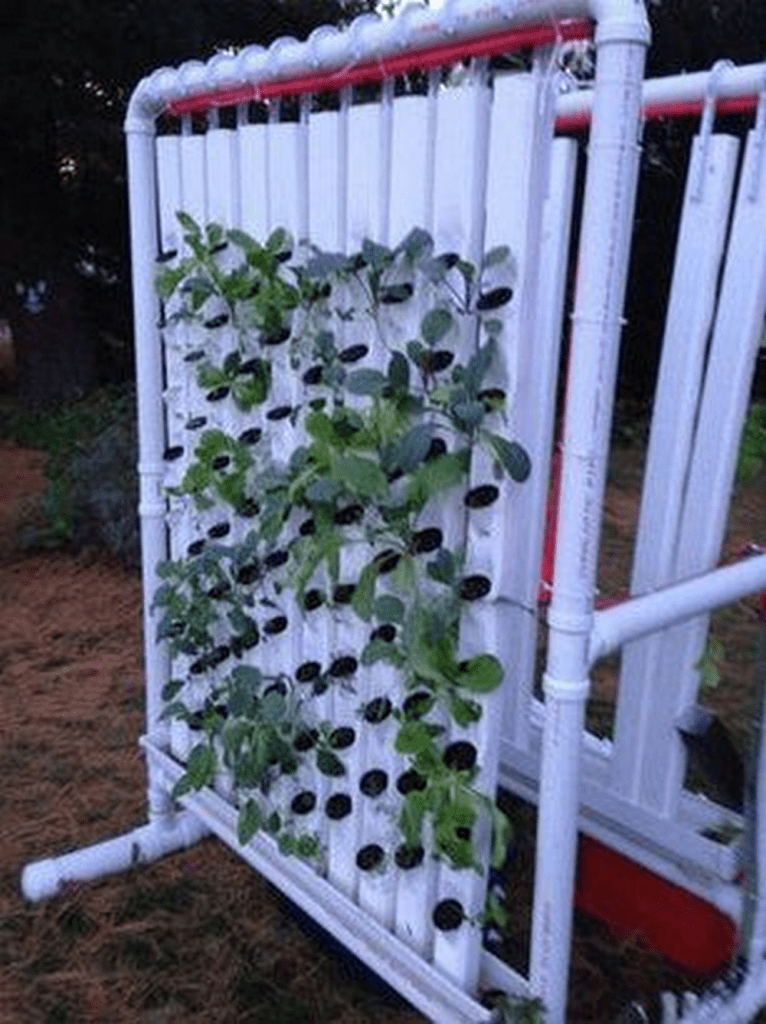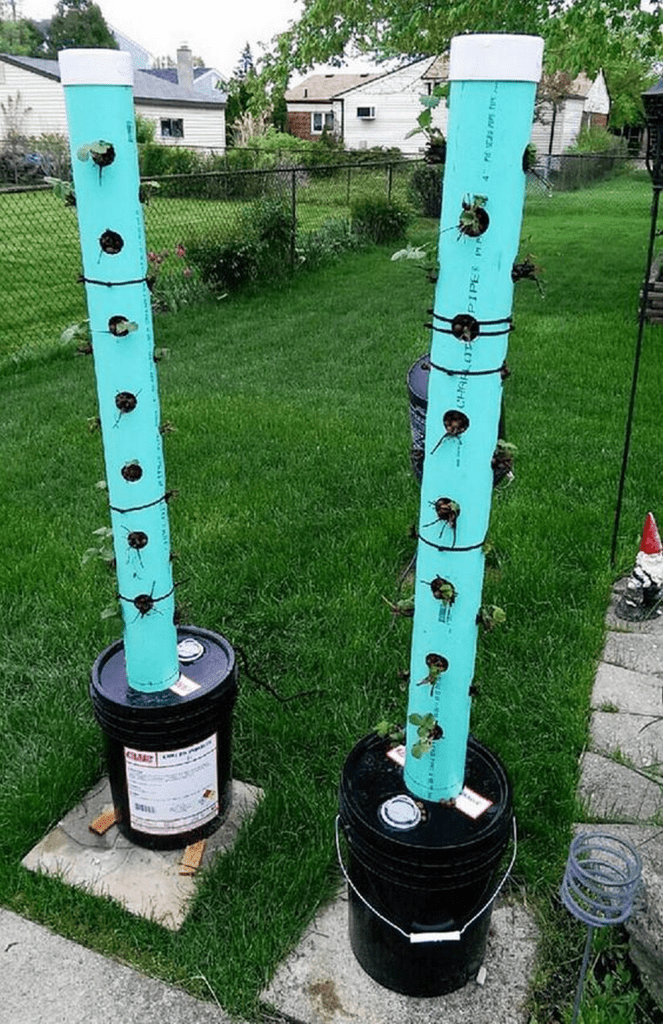Last Updated on April 2, 2024 by teamobn

I love strawberries and I’ve always wanted to grow my own. I wanted to be able to pick them up by myself and eat fresh strawberries right from our backyard. One thing that has stopped me from planting and growing them is my limited backyard space. There isn’t enough space. This is where a strawberry tower comes in.

A couple of years ago, I discovered that it’s possible to grow them vertically. This way, they won’t be taking up too much space in the backyard. Using PVC pipes is pure genius. I give credit to whoever discovered this vertical gardening thing.

Today, we enjoy fresh strawberries at certain times of the year. And they look beautiful, too! This is a project that’s worth your time and effort. Go ahead and build a strawberry tower today!
Building a Strawberry Tower
Contents
Materials
- PVC downpipe with end cap
- Cork
- Duct tape
- Geotextile or Hessian
- Twine
- Soil
- Coarse Gravel
- Strawberry plants
Tools
- Electric Drill
- 2 or 3mm drill bit
- Knife
- Ties
Instructions
Prepare the PVC Downpipe
Take the PVC downpipe and clean it thoroughly. Make sure it’s free from any dirt or dust. The length of the pipe can be adjusted based on your space and the number of plants you wish to grow.
Drill Holes for Planting
Using the electric drill and a 2 or 3mm drill bit, drill holes around the PVC pipe. Space the holes evenly, approximately 6 to 8 inches apart. These holes will be where you insert the strawberry plants. For optimal growth, make sure the holes are large enough to accommodate the roots of the strawberry plants but not so large that the soil will fall out.
Attach the End Cap
Secure the end cap to the bottom of the PVC downpipe. This cap will hold the soil and water within the pipe. Use duct tape around the edges to ensure a snug fit and prevent any leakage.
Add Drainage Layer
Place a layer of coarse gravel at the bottom of the pipe over the end cap. This layer will ensure proper drainage and prevent the roots from sitting in water.
Line the Pipe with Geotextile
Cut a piece of geotextile or Hessian to fit inside the PVC pipe. This lining will help retain moisture and prevent soil from washing out of the holes. Insert it into the pipe, ensuring it extends the full length of the pipe.
Fill with Soil
Start adding soil to the pipe, compacting it lightly as you go to remove air pockets. Continue filling until the soil level reaches the first set of holes.
Plant the Strawberries
Insert strawberry plants into the holes, gently spreading the roots. Ensure the plants are secure and the roots are fully covered with soil. Continue filling the pipe with soil and planting strawberries until all holes are filled.
Top Off with Soil and Water
Once all plants are in place, fill the rest of the pipe with soil. Water the tower thoroughly from the top to ensure the soil is moistened all the way through. This initial watering will help settle the soil around the roots of the plants.
Secure the Tower
Use ties and twine to secure the strawberry tower to a sturdy support if necessary. This step is particularly important in windy areas to prevent the tower from tipping over.
Advantages of Using a Strawberry Tower
Embarking on the journey of cultivating your own strawberries is a delightful endeavour, and when it comes to innovative gardening solutions, the advantages of using a strawberry tower are truly compelling.
This vertical gardening marvel not only redefines the spatial limitations of traditional gardening but also enhances the overall experience of growing fresh, succulent strawberries. Delve into the multifaceted benefits that make this vertical structure a game-changer for both seasoned gardeners and those taking their first steps into the world of home cultivation.
From space optimization and increased harvest potential to streamlined maintenance and sustainable gardening practices, discover how a strawberry tower can elevate your gardening pursuits to new heights, both functionally and aesthetically.
1. Increased Yield: The vertical design of a strawberry tower allows for a higher density of strawberry plants in a smaller footprint. This can lead to an increased yield of fresh strawberries compared to traditional horizontal gardening methods.
2. Ease of Maintenance: Strawberry towers are often designed with accessibility in mind. This vertical structure makes it easier to care for the plants, from watering to pruning and harvesting, reducing the strain on your back and knees typically associated with traditional gardening.
3. Better Pest Control: Elevating strawberry plants can improve pest control. The elevation can make reaching the plants more challenging for ground-dwelling pests, reducing the risk of soil-borne diseases and pests.
4. Improved Air Circulation: The vertical arrangement of a strawberry tower allows for improved air circulation around the plants. This can help prevent fungal diseases by reducing moisture levels and promoting a healthier growing environment for the strawberries.
5. Aesthetically Pleasing: DIY strawberry towers can be aesthetically pleasing additions to your garden or outdoor space. Their vertical structure adds visual interest, and the lush greenery and vibrant red strawberries create a delightful focal point.
6. Customization Options: When you build your strawberry tower, you can customize it to fit your specific needs and preferences. You can choose the materials, dimensions, and design elements, allowing for a personalized gardening experience.
Click on any image to start the lightbox display. Use your Esc key to close the lightbox.









Learn how you can build a strawberry tower by watching this video.
Pro Tips for Building a Strawberry Tower
Elevate your strawberry-growing game with these expert tips for constructing and maintaining a thriving strawberry tower:
Build Upward for Abundant Harvests
Discover the secrets to maximizing your strawberry harvest with a DIY strawberry tower. Effectively utilize vertical space, transforming even the smallest garden or balcony into a thriving strawberry haven.
Elevating your strawberries not only enhances their exposure to sunlight but also makes maintenance more accessible.
Select the Right Components for Success
Embark on your strawberry-growing journey armed with knowledge about the materials that contribute to a successful DIY strawberry tower. From the choice of the container to the selection of soil and the right kind of support structure, only go for the best materials to ensure optimal growth and productivity.
Care for Maximum Yield
Make sure to position your strawberry plants right for optimal sunlight exposure and efficient space utilization. Ensure proper care, including watering schedules, fertilization, and proactive pest management.
Watering Schedules
Establishing and maintaining a consistent, well-regulated watering routine is paramount. Strike a delicate balance by ensuring your strawberry plants receive an adequate but not excessive amount of water.
Tailor your watering schedule based on factors such as prevailing weather conditions, soil moisture levels, and the specific needs of your strawberry varieties. This tailored approach ensures optimal hydration and minimizes the risk of water-related stress or diseases.
Fertilization Strategies
Nourishing your strawberry plants with the right blend of nutrients is essential for robust growth and prolific fruiting. Implement a well-considered fertilization plan that takes into account the unique nutritional requirements of strawberries at different stages of their growth cycle.
Whether opting for organic or synthetic fertilizers, ensure they encompass essential elements such as nitrogen, phosphorus, and potassium to foster healthy plant development.
Proactive Pest Management
Adopt a vigilant and proactive stance against potential pests that may jeopardize the health of your strawberry plants. Regularly inspect your garden for signs of pests, and implement preventative measures such as introducing beneficial insects, using natural repellents, or employing other eco-friendly pest control methods.
Early detection and intervention are key to mitigating potential damage and maintaining a thriving strawberry crop.
Strawberry Varieties Best Suited for Towers
Strawberry towers offer a unique and space-saving way to grow strawberries vertically, making them ideal for gardeners with limited space. Not all strawberry varieties are equally suited for tower gardening, as some thrive better in these conditions than others. Choosing the right varieties can make a significant difference in the success of your strawberry tower.
Below, we explore some of the best-suited strawberry varieties for tower gardening, ensuring you get a bountiful and delicious harvest.
‘Allstar’
A standout among June-bearing varieties, ‘Allstar’ produces large, sweet berries that are exceptionally uniform in size. This variety is known for its resistance to many common strawberry diseases, making it a robust choice for a strawberry tower.
‘Earliglow’
‘Earliglow’ is celebrated for its early ripening and exceptionally sweet flavor. It’s a great choice for getting an early start on the strawberry season. This variety also exhibits good disease resistance, ensuring a healthy crop.
‘Ozark Beauty’
This everbearing variety is known for its vigorous growth and ability to produce an abundant harvest throughout the growing season. ‘Ozark Beauty’ strawberries are large and have a deliciously sweet taste, making them perfect for fresh eating, preserves, and desserts.
‘Quinault’
‘Quinault’ strawberries are soft, juicy, and have a wonderfully sweet flavor. This variety is an excellent choice for a strawberry tower due to its ability to produce fruit in its first year and its resilience in various growing conditions.
‘Albion’
‘Albion’ is known for its large, firm berries with a consistently sweet taste. This day-neutral variety performs well in a wide range of climates and is resistant to many common diseases, making it a reliable choice for strawberry towers.
‘Seascape’
‘Seascape’ produces large, flavorful berries that are perfect for fresh eating. This variety is highly adaptable and can produce fruit throughout the season, from spring through fall, making it an excellent addition to any strawberry tower.
‘Alexandria’
For those interested in smaller, intensely flavored berries, ‘Alexandria’ is a wonderful choice. This alpine variety produces petite strawberries that are packed with flavor. It’s ideal for a strawberry tower, as it doesn’t send out many runners and maintains a compact growth habit.
‘Mignonette’
‘Mignonette’ is another alpine variety that thrives in a strawberry tower setup. It yields small, aromatic berries with a rich, sweet taste. This variety is known for its decorative, compact plants and minimal runner production, making it easy to manage in a vertical garden.
Choosing the right strawberry variety for your tower can significantly enhance your gardening experience and yield. June-bearing, everbearing, day-neutral, and alpine varieties each offer unique benefits and flavors suited to vertical gardening. By selecting one or more of these recommended varieties, you’re setting your strawberry tower up for a productive and tasty harvest.
The Wrap Up
The article highlights the benefits of vertical gardening, particularly through the construction of a DIY strawberry tower, providing insights into maximizing yields. It advises on material selection for durability and plant well-being.
The guide also comes with strategic tips on plant positioning and care, ensuring a consistent harvest of delicious, homegrown berries. Overall, this resource empowers home gardeners with valuable knowledge to enhance their strawberry-growing endeavors, creating a productive and visually appealing garden.
The tips and techniques provided are the building blocks for creating a space that not only yields the fruits of one’s labor but also serves as a source of pride and natural beauty, transforming the ordinary into an extraordinary home garden experience.
For more ways to grow strawberries, check out our milk crate tower next!








